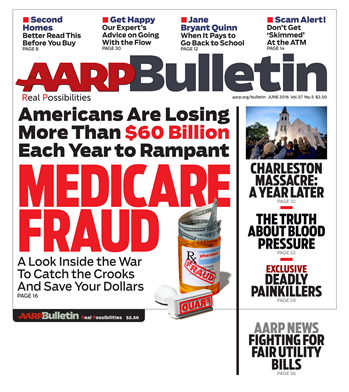June Issue of AARP Bulletin includes a Doctor’s $375 Million Medicare Scam, Charleston Church Massacre A Year Later, and the Rise of Prescription Painkiller Abuse in the U.S.
The current issue also contains financial advice if you are planning on going back to school and lessons on how to protect yourself at the ATM
WASHINGTON, DC — In 2015, a white supremacist opened fire and killed nine people at a church in Charleston, S.C.AARP Bulletin shares the poignant stories of the victims’ families and Reverend Betty Deas Clark, who succeeded slain Reverend Clementa Pinckney as pastor of Emanuel African Methodist Episcopal Church. Read each personal story from the perspective of those most affected by it. June’s cover story exposes Dr. Jacques Roy, who, through his business, Medistat Group Associates, committed $375 million in Medicare and Medicaid fraud—the largest home health care fraud in the history of the two programs. Other Bulletinstories this month include: the rise of prescription painkiller abuse in the United States since the late 1990s; financial advice for those planning on going back to school; and lessons for consumers on how to best protect themselves from thieves at the ATM.
This Doctor Led a $375 Million Medicare Scam (Cover Story): From 2006 to 2011, prosecutors say Dr. Jacques Roy, through his business, Medistat Group Associates, certified over 11,000 Medicare beneficiaries to receive home health care, more than any other doctor in the country. The scheme involved recruiting thousands of healthy patients and billing them for home care that they did not need, netting $375 million from Medicare and Medicaid—the largest home health care fraud in the history of the programs. This April, Dr. Roy was convicted of eight counts of health care fraud and other charges.
Going Back to School?: Better figure out how you’re going to pay for it before cracking the books, says AARP personal finance expert Jane Bryant Quinn and author of How to Make Your Money Last. If you are thinking of returning to school to pick up new money-making skills, it would be wise to investigate the likely pay and availability of the jobs you are aiming for. Your education will be worth its cost only if you will earn more, after tax, than you paid for the course—including the interest due on any student loans. Whatever you choose, motivation, time and motivation are key. You will need to complete the program in order to compete for your dream job and pay off any loans.
Ambushed at the ATM: Fraud at automated teller machines has reached an all-time high. “Skimming” devices let criminals help themselves to your debit card data. Never heard of skimming? It’s a con in which criminals install illegal card-reading devices on ATMs, as well as gas pumps and other public-area machines that process debit cards. Advice here teaches readers how to better protect themselves from this con.
Legal But Deadly: Since the late 1990s prescription painkiller use has experienced a dramatic rise in the United States—and with it, misuse and addiction. A growing number of people 50-plus are abusing prescription painkillers, sometimes with fatal consequences. According to the Centers for Disease Control and Prevention, more than 14,800 Americans fatally overdosed on opioid-based pain medication in 2014—four times as many as in 1999. Of those, nearly 5,900 people were age 50 or older, which is nearly aneleven fold increase since 1999.
The Long Road to Forgiveness: Examining the Charleston church massacre one year later, we ask: what does forgiveness look like? In the eyes of some of those who lost loved ones at Emanuel African Methodist Episcopal Church in Charleston, S.C, an outpouring of bitterness and hatred might have been anticipated from those left behind. Instead, at the accused killer’s first court hearing, many said they had forgiven him. A year later, Emmanuel has been nominated for the 2016 Nobel Peace Prize. The place still echoes with sadness—but listen to the voices and look into the eyes of the victims’ relatives.
###
About AARP Bulletin
The definitive news source for AARP’s members, AARP Bulletin (http://www.aarp.org/bulletin/) reaches more than 23.5 million households each month in print, with additional news and in-depth coverage online. Covering health and health policy, Medicare, Social Security, consumer protection, personal finance, and AARP state and national news developments, AARP Bulletin delivers the story behind the key issues confronting 50+ America. The monthly consumer-oriented news publication has become a must-read for congressional lawmakers and Washington opinion leaders, and it provides AARP members with pertinent information they need to know.
About AARP
AARP is a nonprofit, nonpartisan organization, with a membership of nearly 38 million that helps people turn their goals and dreams into 'Real Possibilities' by changing the way America defines aging. With staffed offices in all 50 states, the District of Columbia, Puerto Rico, and the U.S. Virgin Islands, AARP works to strengthen communities and promote the issues that matter most to families such as healthcare security, financial security and personal fulfillment. AARP also advocates for individuals in the marketplace by selecting products and services of high quality and value to carry the AARP name. As a trusted source for news and information, AARP produces the world's largest circulation magazine, AARP The Magazine and AARP Bulletin. AARP does not endorse candidates for public office or make contributions to political campaigns or candidates. To learn more, visit www.aarp.org or follow @aarp and our CEO @JoAnn_Jenkins on Twitter.
Media Contacts:
Brian Moriarty, DKC PR, 212-981-5252, Brian_Moriarty@dkcnews.com
David Helfenbein, DKC PR, 212-981-5185, David_Helfenbein@dkcnews.com
Paola Torres, AARP, 202-434-2555, ptorres@aarp.org
























































